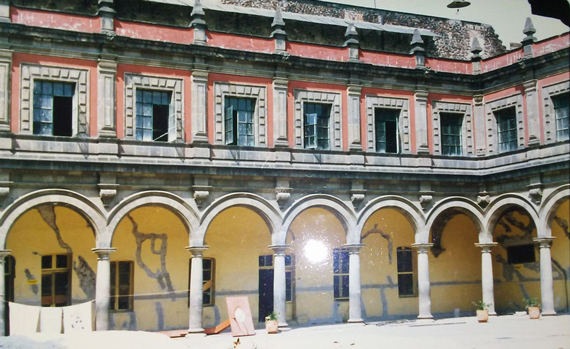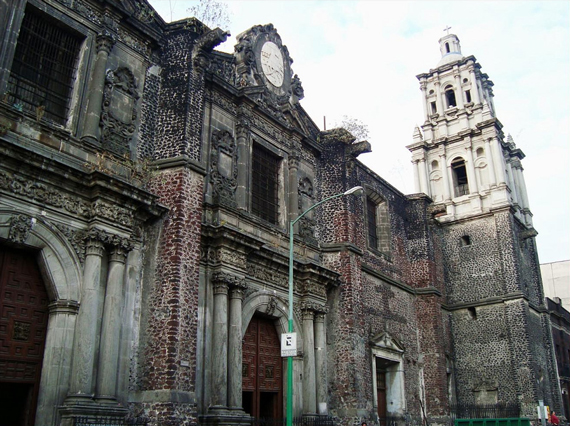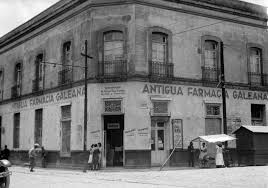|
Remembering the 1985 Earthquake in Mexico City
November/December 2017
By Maria E Curry
 Building on San Ildefonso Street, #46, used as a middle school. Photo by Maria Curry |
 Ex-Convento de la Concepción on Belisario Dominguez Street, #5. Photo courtesy google.mx |
 Old photo of house on Galeana Street, #37. Photo courtesy google.mx. |
With the recent devastating earthquakes in Mexico, I'm haunted by memories of what happened 32 years ago in my hometown, Mexico City. In 1985, a major earthquake damaged thousands of buildings there, demonstrating the utter fragility of an area that I had considered indestructible.
The aftermath showed me the tremendous impact of community solidarity, when people organized spontaneously in response to the tragedy and government corruption, rescuing people and repairing buildings. The collapse of historic monuments and houses in Mexico City's traditional neighborhoods, followed by restoration work with ample public participation, allowed me to discover what I wanted to do as a professional and as a human being for the rest of my life.
On September 19, 1985, I was going to work when a felt my car sinking while driving on a bridge. After I got to our parking lot, I saw people running out of a building. That's when I realized we were having an earthquake. More than 5,000 people died and almost 500 buildings collapsed while thousands others were damaged. In the years to come, the city was to be rebuilt and I was able to help in the restoration of significant historic buildings.
First, let's go back a few years. In 1982, I finished my master's studies in the Restoration of Monuments at the Universidad Autónoma de Mexico. I had worked on restoring the San Jerónimo ex-convent in 1981 and in the documentation of 80 cities and towns with the federal government for three years. However, back then, restoring monuments in downtown Mexico City was a job reserved for the best-trained preservation architects.
After the earthquake, the great need for repairing buildings, new and old, allowed me to join the Delegación Cuauhtémoc, a Mexico City government entity, as a supervisor in the restoration of several important historic resources, including the ex-Convento de la Concepción (1540), the first convent built for women in Mexico. Many famous women lived in seclusion here, including, in 1552, two granddaughters of Montezuma, the Aztec emperor when Cortez arrived.
The convent was partially built on top of a pyramid, creating great controversy between the city and preservation engineers when we had to make decisions for repairing the damages. Pre-Hispanic buildings have priority over Colonial buildings in Mexico, even if the first ones are only ruins, as was the case here. Structural engineers recommended reducing the remains of the pyramid, located under the convent's tower, but city officials did not agree with that solution, mainly for political reasons. Fortunately, the recent earthquake did not affect this building, but its future is uncertain.
For my master's degree, I presented a restoration project for a 19th-century apartment house damaged by the earthquake and threatened with demolition: Galeana Street, #37 in Colonia Guerrero, an old neighborhood near downtown. I worked with eight architecture students from the Escuela de Estudios Superiores de Aragón in support of a grassroots organization named Unión de Vecinos de la Colonia Guerrero, a group fighting gentrification and displacement. The project helped save the apartment house and it became part of a housing program supported by the federal and local governments with international grants.
This apartment house has great architectural value and is associated with the life of important people in the Mexican film industry, astronomy, and political life. It is a two-level complex in the Colonial Eclectic style with three structures and a central patio. Originally, it housed 25 apartments and 10 commercial areas.
I learned many lessons from the 1985 tragedy, including how to be a social activist in historic preservation. Recently, I presented my experience to students at the University of Durango architecture school in Tijuana, and we talked about documenting Baja California's old buildings as a preventive measure in case of a disaster. I urged them to be aware of and get involved in what happens in their communities because old buildings are threatened by neglect, abandonment, development, and also disasters.
Their teacher, architect Fernando Quiroz, told me his students were very inspired by my talk and are already looking in archives for historic information on old buildings. We want to build on their interest and initiative: Fernando and I are organizing a workshop for next year to train professionals and students with basic skills to protect threatened historic buildings and monuments in Baja California.
|
2024
2023
2022
2021
2020
2019
2018
2017
2016
2015
|






